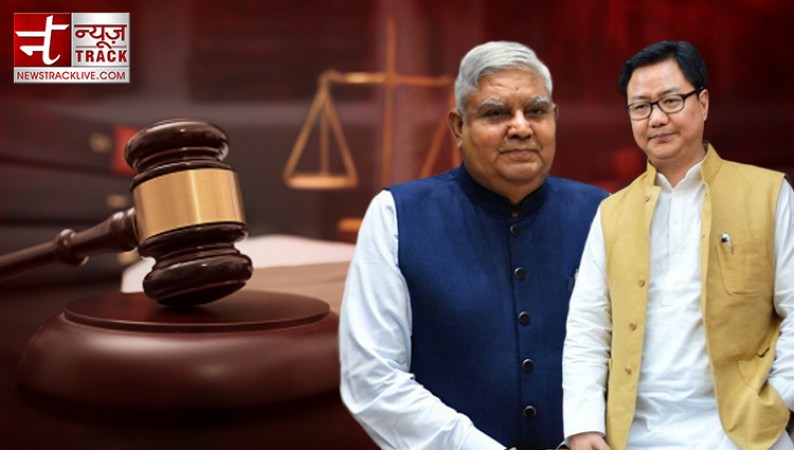
New Delhi: There is a situation of confrontation between the Center and the Supreme Court Collegium regarding the process of appointment of judges. A contempt petition was filed in the Supreme Court regarding this matter. Hearing this, the apex court warned the Center to take strict action. After this, while filing an affidavit, the Center has said to approve the recommendations for the appointment of judges in 5 days.
In fact, the Advocates Association of Bengaluru had filed a contempt petition after the Center raised questions on the appointment of judges. The top court had expressed its displeasure over the delay in giving approval by the central government for the appointment of judges. The court had said, 'This is a very serious matter. Do not force us to take such a stand, which will cause problems.' On the other hand, a petition has been filed in the Bombay High Court against Vice President Jagdeep Dhankhar and Union Law Minister Kiren Rijiju for criticizing the collegium system. The Bombay Lawyers Association, in its petition, has demanded the removal of Dhankhar and Rijiju from their posts.
However, after the Supreme Court warned of a tough stand, the central government told the court that it would approve the recommendations sent by the collegium in five days. In such a situation, the question in the mind of the people is, can the Bombay High Court take any decision to remove the Vice President and the Law Minister? In such a situation, we have to first understand the election of the Vice President, only then we will be able to understand the process of his removal.
How is the Vice President elected?
The post of Vice President is a constitutional post, which is the second highest post in the country after the President. The term of the Vice-President is 5 years, but even after the end of the term, he can continue in office until his successor takes charge. The election of the Vice-President is mentioned in Article 324 of the Constitution along with the Presidential and Vice-Presidential Election Act 1952 and the Presidential and Vice-Presidential Election Rules 1974. The election of the Vice President is conducted, directed, and controlled by the Election Commission of India (ECI).
The notification for the election of the Vice President is issued 60 days before the end of the term of the current Vice President. Thereafter, the Election Commission, in consultation with the Central Government, appoints the Secretaries General of the Lok Sabha and the Rajya Sabha as Returning Officers by rotation. After this, voting takes place in the Parliament House for the election under Rule 8 of the Presidential and Vice-Presidential Election Rules, 1974. In this election, the representatives of both houses of the parliament vote. According to Article 66 of the Constitution of India, the Vice President is elected by the members of the Electoral College. The Electoral College consists of the elected MPs of the Rajya Sabha, the nominated members of the Rajya Sabha, and the elected MPs of the Lok Sabha.
Procedure for removal of Vice President:-
Let us tell you that the Vice President is also the Chairman of the Rajya Sabha, the Upper House of the Parliament. However, he does not hold any office of profit. The Vice President can leave his office by submitting his resignation to the President of India. It becomes effective from the day the President accepts the resignation. On the other hand, if we talk about the removal of the Vice President, then the process of impeachment is initiated to remove him from the post by a resolution of the Upper House. But, for that too, this proposal needs to be passed by the majority of the members present in the house. After passing in the Rajya Sabha, the motion of impeachment goes to the lower house of the Parliament i.e. Lok Sabha, here also it needs to be passed by a majority.
At the same time, a notice of at least 14 days is required to be given before moving the motion. That is, if seen in this way, the Vice President cannot be removed from office by the High Court or the Supreme Court. The process of removal of the Vice President is done in the Parliament and he can be removed only according to the rules mentioned in the constitution. However, the Vice-President can be removed from his office on grounds of electoral malpractice relating to the election of the Vice-President under Article 71(1) of the Constitution or on being disqualified for any reason under Article 71(3).
Procedure for appointment and removal of minister:-
Let us tell you that the cabinet comes under the prime minister. In such a situation, the President has the power to remove a minister from office. In addition, any minister can be relieved of his post on the advice of the Prime Minister. Apart from this, if the minister is disqualified in any case by the court, then he can be relieved from the post. However, so far the court has not disqualified Delhi's Jail Minister Satyendar Jain, who is in jail for the last 8 months in a corruption case. In such a situation, this process is also very complicated.
How UP changed in last 6 years? Reached the top in the country's economy
Australia will miss Zampa's ability to zip ball against India: Sriram
FOREX reserves rise for 3rd consecutive week, hits 6-month high